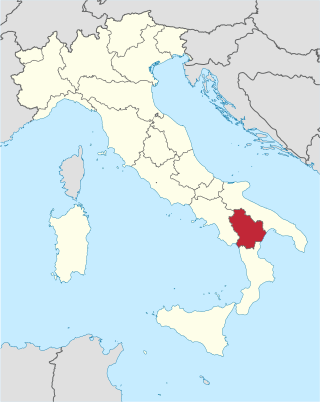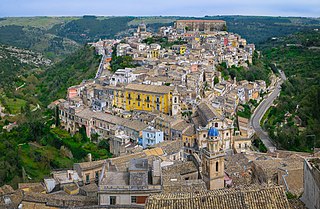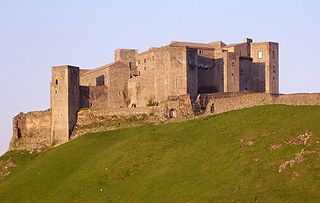
Molfetta is a town located in the northern side of the Metropolitan City of Bari, Apulia, southern Italy.

Basilicata, also known by its ancient name Lucania, is an administrative region in Southern Italy, bordering on Campania to the west, Apulia to the north and east, and Calabria to the south. It has two coastlines: a 30-km stretch on the Tyrrhenian Sea between Campania and Calabria, and a longer coastline along the Gulf of Taranto between Calabria and Apulia. The region can be thought of as the "instep" of the "boot" of Italy, with Calabria functioning as the "toe" and Apulia the "heel".

Ragusa is a city and comune in southern Italy. It is the capital of the province of Ragusa, on the island of Sicily, with 73,288 inhabitants in 2016. It is built on a wide limestone hill between two deep valleys, Cava San Leonardo and Cava Santa Domenica. Together with seven other cities in the Val di Noto, it is part of a UNESCO World Heritage Site.

Angolo Terme is a comune in Val Camonica, province of Brescia, in Lombardy, Italy. It lies on the right bank of the river Dezzo, in the lower Valle di Scalve.

Iseo is a town and comune in the province of Brescia, in Lombardy, Italy, on the south shore of Lake Iseo. It is bounded by the communes of Provaglio d'Iseo, Sulzano, Polaveno and Paratico.
Bianzano is a comune in the province of Bergamo, in Lombardy, Italy. It is 600 meters (2,000 ft) above sea level and lies on a little plateau between Cavallina and Seriana valleys. The village boasts a historic center, having kept its original structure with some remains of minor fortified buildings and the imposing medieval Suardi Castle overlooking the valley. Other two outstanding monuments are the shrine of Our Lady of the Assumption (1234) and the parish church dedicated to Saint Roch (1575).

Rapolla is a town and comune in the province of Potenza, in the Southern Italian region of Basilicata. It is bounded by the comuni of Barile, Lavello, Melfi, Rionero in Vulture, Venosa.

Melfi is a town and comune in the Vulture area of the province of Potenza, in the Southern Italian region of Basilicata. Geographically, it is midway between Naples and Bari. In 2015 it had a population of 17,768.

Caserta is the capital of the province of Caserta in the Campania region of Italy. An important agricultural, commercial, and industrial comune and city, Caserta is located 36 kilometers north of Naples on the edge of the Campanian plain at the foot of the Campanian Subapennine mountain range. The city is best known for the 18th-century Bourbon Royal Palace of Caserta.

Piazza Armerina is a comune in the province of Enna of the autonomous island region of Sicily, southern Italy.

Montecatini Val di Cecina is a small hilltown and comune in the province of Pisa in Tuscany. Located approximately 60 kilometres south of Pisa, the medieval town sits on the Poggio la Croce hill overlooking the Cecina Valley and the larger hilltown of Volterra, which lies just 15 km away.

Zagarise is an Arbëreshë village and comune in the province of Catanzaro in the Calabria region of southern Italy.

San Fili is a village and comune in the province of Cosenza in the Calabria region of southern Italy.

Sant'Ambrogio di Torino is a comune (municipality) in the Metropolitan City of Turin in the Italian region Piedmont, located about 25 km west of Turin in the Susa Valley.
Viguzzolo is a comune (municipality) in the Province of Alessandria in the Italian region Piedmont, located about 100 kilometres (62 mi) east of Turin and about 25 kilometres (16 mi) east of Alessandria. As of 31 December 2004, it had a population of 2,964 and an area of 18.3 square kilometres (7.1 sq mi).

Castel Lagopesole, or simply Lagopesole, is a village and civil parish (frazione) of the municipality (comune) of Avigliano, in Basilicata, southern Italy. It has a population of 652.

The Castle of Melfi in Basilicata is a monument owned by the Italian State and one of the most important medieval castles in Southern Italy. Its construction, at least the components still visible, dates back to the Norman conquest and has undergone significant changes over time, especially under the House of Anjou and the Crown of Aragon.

San Pietro alle Scale, also known as San Pietro in Castelvecchio is a Roman Catholic parish church located on via San Pietro, Terzo of Città, in Siena, region of Tuscany, Italy. Initially built in the 12th century, this parish church was completely rebuilt in a Baroque style in the 17th century; the brick facade has a portal with a depiction of Glory of St Peter. The belltower dates to 1699, and the facade to 1706.

The Abbey of Santissima Trinità or Abbey of the Most Holy Trinity, Italian: Abbazia della Santissima Trinità, is a Roman Catholic abbey complex at Venosa, in the Vulture area of the province of Potenza, in the southern Italian region of Basilicata. The architecture of the abbey shows Roman, Lombard, and Norman influences. The complex lies within the Parco Archeologico of Venosa, approximately 1.5 km north-east of the town; it falls under the Roman Catholic Diocese of Melfi-Rapolla-Venosa. It consists of the old church, of uncertain date; the monastery buildings; and the Incompiuta, the unfinished or new church, begun in the last quarter of the eleventh century and never completed. The complex was declared a National Monument by Royal Decree on 20 November 1897. It is no longer a monastery, but is used by the Trinitarian Order.

The Church of St Catherine of Alexandria, commonly known as the Church of St Catherine of Italy is a Roman Catholic church in Valletta, Malta. It was built by the Hospitaller Langue of Italy and it serves as the parish church of the Italian community of Malta.


















